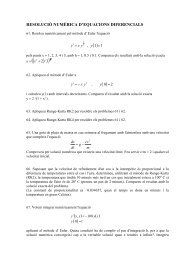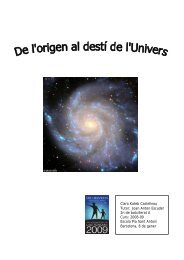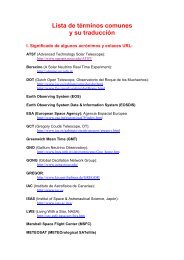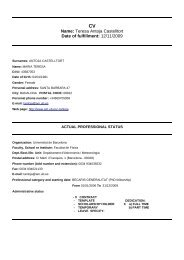Universitat de - Departament d'Astronomia i Meteorologia ...
Universitat de - Departament d'Astronomia i Meteorologia ...
Universitat de - Departament d'Astronomia i Meteorologia ...
Create successful ePaper yourself
Turn your PDF publications into a flip-book with our unique Google optimized e-Paper software.
5.3. Optical observations 135<br />
Figure 5.1: Optical images and radio maps, grouped in pairs, of the six sources listed in<br />
Table 5.1. The 2 ′ × 2 ′ optical images were obtained through the I Johnson filter with<br />
the CAHA 2.2 m telescope on 1999 December 11, and circles have been used to clearly<br />
mark the optical counterparts. The radio maps, computed using uniform weights, are<br />
the result of concatenating, for each source, all VLA 1999 July observations at 3.6 cm<br />
wavelength, while the crosses indicate the optical positions with the 1σ 0.3 ′′ astrometric<br />
errors. The radio maps are 2 ′′ × 2 ′′ wi<strong>de</strong> for all sources except for the last one, where a<br />
4 ′′ × 4 ′′ map has been plotted to allow the inclusion of the close SE optical object. The<br />
synthesized beam is plotted in the bottom left corner of each map. The radio contours<br />
start at a signal-to-noise ratio of 6 for all sources except for the last one, where a value<br />
of 15 has been used, in or<strong>de</strong>r to avoid reproducing cleaning effects at low signal-to-noise<br />
ratios in all cases.<br />
5.3 Optical observations<br />
Having in mind the goal of i<strong>de</strong>ntifying the optical counterparts, CCD observations<br />
were ma<strong>de</strong> at Calar Alto (Almería, Spain) with the 1.5 m telescope of the Observa-<br />
torio Astronómico Nacional (OAN), between 24 and 30 November 1998. We used<br />
the Ritchey-Chrétien focus and a Tektronics TK1024AB chip that provi<strong>de</strong>s a scale<br />
factor of 0.4 ′′ per pixel and a 6.9 ′ × 6.9 ′ field of view. Deep CCD images were ob-<br />
tained for all our candidates, with the exception of 1RXS J181119.4−275939 and<br />
1RXS J185002.8−075833 that were not visible at the epoch of our observations. The<br />
images were taken with the V , R and I Johnson filters, and the exposure times were<br />
typically of 600–1200 seconds. Although the images were useful for photometric<br />
measurements, their quality did not allow us to obtain accurate positions.<br />
Complementary CCD observations were conducted on 1999 December 11 also at<br />
Calar Alto, but using in this case the 2.2 m telescope of the Centro Astronómico<br />
Hispano-Alemán (CAHA). Images were obtained using the Ritchey-Chrétien focus<br />
and CAFOS, leading a scale factor of 0.53 ′′ per pixel and a 8.8 ′ × 8.8 ′ field of view,<br />
through the I Johnson filter and with exposure times between 180 and 600 seconds.<br />
The good quality of these images allowed us to perform accurate astrometric mea-<br />
surements, although no precise photometric information could be obtained since the<br />
images could not be photometrically calibrated.<br />
The observations were reduced using standard procedures within IRAF.






